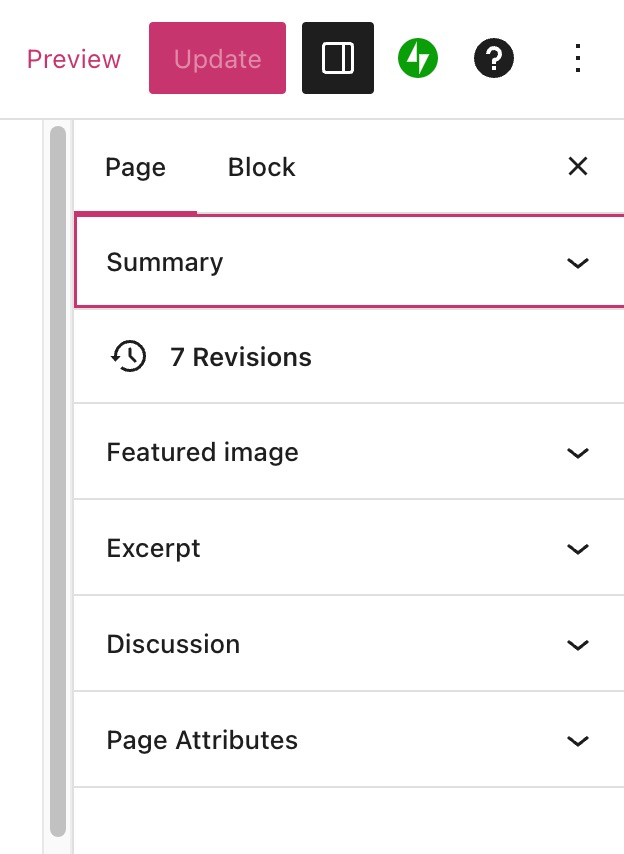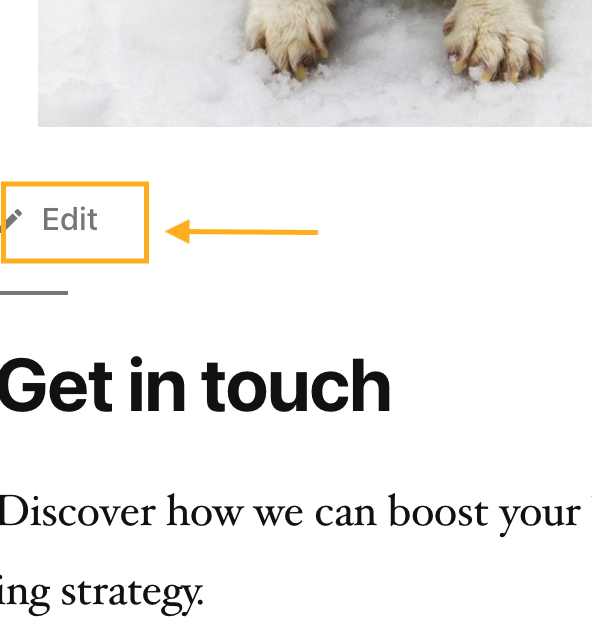Page Management
The content below is directly from WordPress.
Ensuring you have the most accurate instructions.
Video Tutorial
How to create a page in WordPress – Transcript
Create a New Page
To add a new page to your website, take the following steps:
- Visit your dashboard.
- Click on Pages on the left side.
- Click on the “Add new page” button.
- Choose from a large collection of readymade page layouts, or click “Blank page” to create an empty page.
- Give your page a title by typing it in the box at the top that says “Add title“.
- If you selected a page layout in step 4, a title will have been added for you. You can edit this title if you wish.
- Click on the + block inserter icon to add new content, or click on any block to edit existing content (learn how to use the WordPress editor here!)
Adjust the Page Settings
When working on a page, you’ll find the page settings in the sidebar on the right side of your screen.
If you do not see the sidebar on the right, click the Settings icon in the top right corner to bring up the settings. This icon looks like a square with two uneven columns:

You can control the following aspects of the page here:
- Under Summary, you will find the following options:
- Use Visibility to make the page public, private, or protected behind a password. Learn more.
- Set the page to Publish immediately or choose a date and time in the past or future. Learn more.
- Select the Template that will control how the content of your page is presented. Page is the default template for pages. Learn more.
- See and change the URL of the page. Learn more.
- Mark the page as “Pending review” for other users of your site. Learn more.
- Change the author of the page to another user on your site.
- On already-published pages, a “Switch to draft” button will appear. Click this to revert the public page to a non-public draft.
- Delete the page by clicking the “Move to trash” button. Learn more.
- Write an excerpt to describe the page. Learn more.
- Revisions: Using revisions, you can restore previously saved versions of the page. This option will appear only after you have saved some changes to the page. Learn more.
- Choose a featured image to represent the page. Learn more.
- Discussion: Allow people to leave public comments on the page. Learn more.
- Page Attributes: Select the page’s parent and order number. Learn more.

Publish a Page
In the top right of the screen, above the page settings, you’ll see several options for your new page:

These options are:
- Save draft: Save the latest version of your draft page.
- If this shows Saved instead, it means the latest version of your draft has been saved successfully.
- Preview: See what your page will look like on desktop, mobile, and tablet screens. Click Preview in new tab to see how the changes will look on the live site.
- Publish: Publish the draft page to your website.
- Settings Icon: Show or hide the page settings.
- Jetpack Icon: Show or hide additional options provided by the Jetpack plugin:
- Shortlink: Copy a shortened URL of the page.
- Social Previews: See how the page will appear on Google and social media.
- Likes and Sharing: Enable the Like button and social media sharing buttons.
- SEO: Customize the title and description of the page (eligible plans only.)
- QR Code: Generate a QR code for the published page.
- Help Icon: Open up the help center to search for guides or access support.
- Ellipses Menu (the three vertical dots): Open additional editor settings.
Edit a Page
After publishing a page, you can return to the page to continue editing it:
- Visit your dashboard.
- Click on Pages on the left side.
- Choose from one of the following tabs:
- Published: Pages you have published to your site.
- Drafts: Pages you have started but have not yet published.
- Scheduled: Pages you have set to be published at a future date.
- Trashed: Pages that will be deleted after 30 days.
- Locate your page in the list and click the title of it to open the editing screen.
When viewing your website publicly, you may also see a link that says “Edit”, “Edit page”, or “Edit this page” to quickly open the page editor. The availability of this link depends on your browser settings and your site’s theme, and can’t be removed.
The link will only show to you as the site owner, while logged into your account. It will not appear to your visitors — no visitor would have the power to edit your site.

A published page will show the following options at the top of the screen:

- View page (arrow icon): Open the live version of the page in a new browser tab.
- Preview: See what your page will look like on desktop, mobile, and tablet screens. Click Preview in new tab to see how the changes will look on the live site.
- Update: Save your changes to the already-published page.
Share Your Page
Once you have published your page, you’ll want your website visitors to find it. There are several methods to do so:
Add the Page to your Navigation Menu
A website typically displays a menu of pages for visitors to browse through. You can add any published page to your menu – see Add Links to a Menu to learn how.
Share the Page URL
Every page has a unique URL you can use to share the page with the world. To find the page’s URL:
- Visit your dashboard.
- Click on Pages on the left side.
- Locate your page in the list and click the three dots next to the page’s name.
- Click the Copy link option.
The link will be copied to your computer’s clipboard for you to share on social media, in an email, or anywhere you’d like.

Set Your Homepage
To make your newly published page the first page visitors see when arriving on your site, you can set it as your site’s front page. See Set the Homepage to learn how.
Find the Page ID
You can find the page’s ID in your browser’s address bar after opening the page in the editor. For example, the page ID for the following example is “58167694”:


